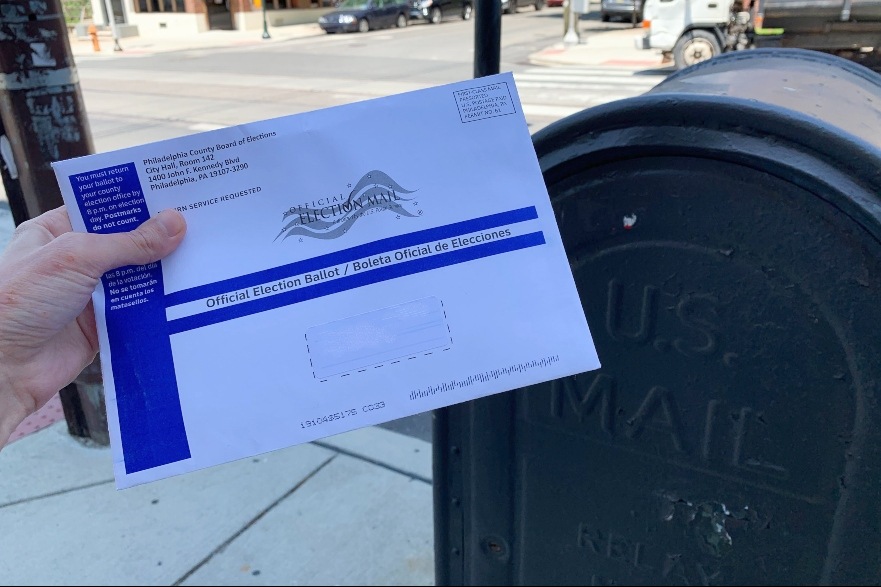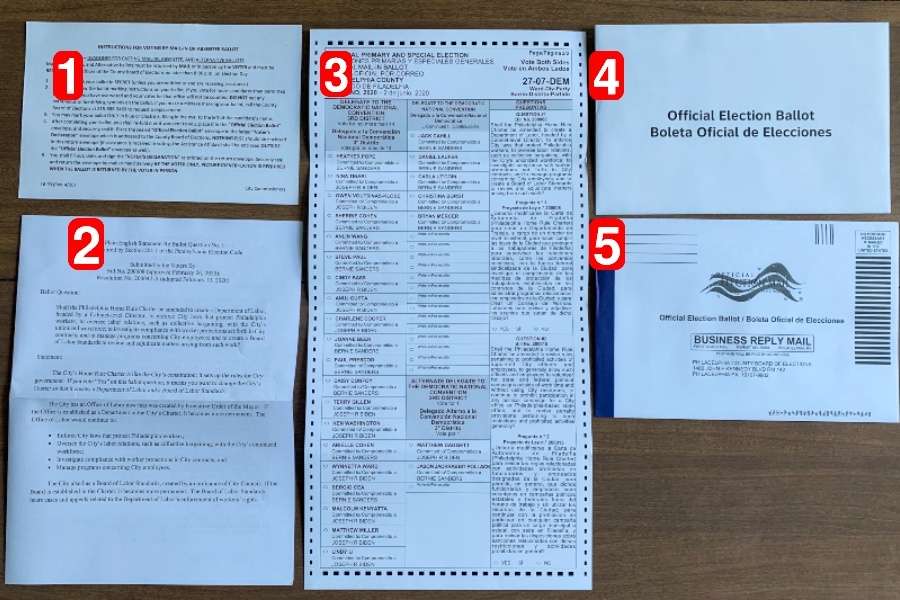Here’s Everything You Need to Know About Filling in Your Surprisingly Complicated Mail-In Ballot
It's not as simple as checking off a few boxes. A Philadelphian's guide to making sure your vote in the Pennsylvania primary is counted.

Do you have questions about how to fill out your Pennsylvania mail-in ballot? We’re here to help. Photo by Claire Sasko
So you got your election ballot in the mail. Great! Now you can vote without ever showing up at the polls.
Assuming many of you are first-timers to this process, we’ve prepared a step-by-step guide for Philadelphians on how to use the Pennsylvania mail-in ballot correctly. If you’ve already received it, you may have realized by now that filling it out isn’t the simplest of processes. There are a lot of specific steps to follow. We’ll help with that below.
But before we do that: If you haven’t signed up for a mail-in ballot yet but would like to, check out our guide to doing so here. You still have time, but be sure to sign up as soon as possible: May 26th is the deadline to apply for a mail-in or absentee ballot. You must be registered to vote to sign up for a mail-in ballot, and you’ve still got a few days to do that; the deadline to register to vote in the June 2nd primary is May 18th. Click this link to register to vote, or call 1-877-VOTESPA.
Once you’ve (1) registered to vote; (2) signed up for a mail-in ballot; and (3) received your mail-in ballot, congrats! You’re now ready to vote. For whatever reason, you’ve chosen to forgo visiting the polls this year. Maybe you’re immunocompromised, or maybe crowds have always made you uncomfortable. That’s all right. Just be sure to vote. You’ve waited four long years for this opportunity.
So let’s get to it. Here’s a step-by-step guide to the process.
1. Wait for your official election ballot — and contact your county election office if you have any questions
After you sign up for a mail-in ballot, you should receive a confirmation email from the state that says “Thank you for submitting your ballot application online. The Philadelphia County Election Office received your application on [whatever date you submitted it].”
When your application is processed and accepted, you should receive another email. During this time, if you have any questions or if you suspect your application has not been approved, contact your county election office. The number for Philadelphia County is 215-686-1509; you can find a list of other county election office phone numbers here.
After that, you’ll receive a third email when your ballot is being prepared for mailing. This email will say, “If you do not receive your ballot in the next 5-7 days, please contact your county election office.” You should receive your ballot within the stated time window (I actually got mine before receiving that email), but if not, follow those instructions and contact your county election office.
2. Open your mail-in ballot and get familiar with the materials

Pennsylvania mail-in ballot materials | Photo by Claire Sasko
Once you’ve received your mail-in ballot, open it up and check out the materials. Inside, you’ll find:
- Instructions for voting by mail-in or absentee ballot
- A pamphlet explaining the ballot questions (there are two in Philadelphia this year), provided in English and Spanish
- Your ballot
- An envelope in which to place your ballot
- A larger mailing envelope (stay with me here) in which to place the smaller envelope that should hold your ballot — you’re going to fill the larger one out with your return address, signature and the date
Does your mail-in ballot envelope include all of those things? Great! If not, contact your county election office. (I’m going to say that a lot.)
3. Acknowledge the mail-in ballot deadline
Find the sheet of paper marked “INSTRUCTIONS FOR VOTING BY MAIL-IN OR ABSENTEE BALLOT.” You’ll notice that it says all mail-in and absentee ballots must be received in the offices of the County Board of Elections no later than 8 p.m. on Election Day. (There’s a slight difference between absentee and mail-in ballots, by the way — which we break down here — but every registered voter is entitled to use a mail-in ballot, whether or not they have a reason.)
Because we all know mail can be slower than expected (especially during a pandemic), be sure to send in your ballot as soon as you feel comfortable doing so. Read: Don’t wait until 7 p.m. on Election Day to take it to the post office. If you do wait too long and you’re nervous it won’t be received in time via mail, take it to your county election office in person. You can find office addresses in addition to contact information here.
You should probably opt to mail in your ballot early to be safe — after all, the main reason you signed up for a mail-in ballot is likely because you don’t want to stand in a line to vote. But remember that taking it to the office in person is always an option. Better to ensure your vote is received than risk sending it too late. Just take note: Photo identification is required if you’re returning your ballot in person.
4. Fill out your ballot (in pen!)
Let’s start with step one on the instruction sheet: Mark your ballot in secret. Since we’re all practicing social distancing right now, this shouldn’t be too hard.
Then grab a black or blue ink pen. As the instructions say, you must mark your ballot ONLY in blue or black ink. So don’t use a pencil. This isn’t the SATs. But like the SATs, be sure to completely fill in the oval to the left of your desired candidate’s name; don’t write a check mark or a star or a smiley face inside the oval.
Start with the first page of your double-sided ballot. (You can see page numbers in the ballot’s top right margins. You don’t have to start with page one, but doing so will probably make the process easier. The second page is the trickier one to figure out.)
On the first page, Philadelphians have the option to vote for the following offices: President of the United States (the big one!); state attorney general; state auditor general; state treasurer; your district’s U.S. Congressional representative; and member of the Pennsylvania House of Representatives.
On the second page, you have the option to vote for delegates to your party’s convention. For instance, if you’re a Democrat in Philadelphia, you can choose up to 14 delegates to the Democratic National Convention; one alternate delegate to the DNC. This is also where you vote on the aforementioned two ballot questions.
If you need a DNC delegate explainer — and most people probably do — you can refer to either of these helpful guides from Vox or CNN. Wondering why Bernie Sanders is still on the ballot after conceding defeat in April? While the Vermont senator has said he views Biden as the presumptive 2020 Democratic nominee, he will remain on the ballot in states with primaries to gather delegates in hopes of inspiring a more progressive party platform. You can read more on that here.
Only vote for the permitted number of candidates for an office. If you vote for more than the permitted number, your votes for that office won’t be counted. And don’t put any “extraneous or identifying symbols on the ballot” — which is to say, don’t doodle on it during an interminable Zoom meeting.
One more important piece of information: If you make a mistake marking your ballot? You guessed it: Call your county board of elections as soon as possible to request a replacement.
5. Refold your ballot and place it in your “Official Election Ballot” envelope. Seal it, then place it in the larger voter’s declaration envelope.
Here’s where those two envelopes come into play. Refold your ballot as you received it and place it in the smaller envelope that only reads “Official Election Ballot / Boleta Oficial de Elecciones.” This envelope is otherwise blank.
Seal that envelope and place it in the larger mailing envelope, which is also your voter’s declaration envelope. It should be obvious, but just in case: This one will have an official logo that reads “OFFICIAL ELECTION MAIL Authorized by the U.S. Postal Service” and the text: “BUSINESS REPLY MAIL”, etc.
Nothing else should be enclosed in these envelopes. You should only send your ballot inside the smaller envelope inside the larger envelope.
6. Fill out your voter’s declaration envelope
We’re nearing the end here. On the back of that larger voter’s declaration envelope, you’ll see where you’re intended to sign your voter’s declaration. Sign where it says “Voter, sign or mark here,” then fill out the date, print your name, and write your address.
If you need assistance filling out and signing your ballot because of illness or physical disability, your witness will fill out the declaration on the righthand side. If you don’t need assistance, you don’t need to fill out the righthand section.
7. Mail — or turn in — your ballot
Once everything is done, seal the envelope and send it by mail. You don’t need a stamp — you’ll notice the return envelope says “NO POSTAGE NECESSARY IF MAILED IN THE UNITED STATES.”
If you’re delivering your envelope by hand, you’ll need to take it to your county election office yourself. No one else can bring it for you. And you must present photo identification.
When all that is done, exhale and pat yourself on the back. You’ve just voted by mail! Now you can sit back, relax, and watch the June 2nd primary unfold without ever leaving your home on Election Day.
If you don’t receive confirmation that your ballot has been received as Election Day nears (you can track your ballot’s status here) — and yes, this is the last time I’ll say it — contact your county election office.


